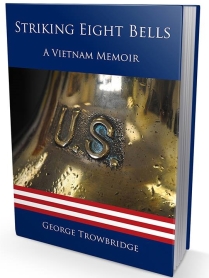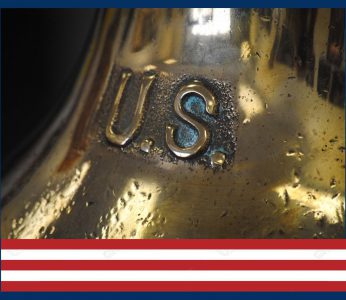Story expanded on from: “Striking Eight Bells: A Vietnam Memoir.”
For the U.S. Navy in Vietnam, 1972 would prove to be a busy year of conducting numerous and dangerous combat operations.
On August 27, 1972, off the Do Son Peninsula and Cat Ba Island area at the entrance to Haiphong Harbor a raid was carried out by Task Unit 77.1.2., which included four ships USS Newport News (CA 148), USS Providence (CLG 6), USS Robison (DDG 12), and USS Rowan (DD 782). This raid would later come to be known as “The Battle of Haiphong Harbor” also called “Operation Lion’s Den.” This action also included one of the few ship-to-ship naval battles of the entire Vietnam War.

Captain John Renn, the commander of Destroyer Squadron 25, led the raid from USS Robison (DDG 12). Admiral James L. Holloway III, the Seventh Fleet commander, also participated as an observer on USS Newport News (CA 148).[1]
At 2200, Newport News went to general quarters as it approached the area in column with the other ships. Holloway joined the skipper of Newport News, Captain Walter F. Zartman, on the bridge, but assured the captain that he was just an observer and “would stay out of his hair.” The four ships approached the channel at 25 knots and began firing on targets two and a half miles southeast of the Do Son light.[2]
Shore batteries soon returned fire, giving the U.S. ships excellent aim points for counterbattery fire. Unlike U.S. Navy projectiles, which employed flashless powder, the powder in the North Vietnamese rounds caused brilliant muzzle flashes. It was later estimated that enemy gunners fired approximately 300 rounds at American ships that night, but none found its mark.


Newport News ceased firing at 2333 and prepared to egress from the harbor. Captain Zartman informed Holloway that all of the ship’s targets “had been covered” and that secondary explosions were noted at Cat Bi airfield and an ammunition dump. A short period after cease fire, Combat Information Center (CIC) reported a surface target, designated as, “Skunk Alpha, at 10,000 yards bearing 088 degrees, heading for us at high speed.”[1]
The P-6-class Soviet-manufactured fast patrol boat had waited to ambush Newport News in the vicinity of Ile de Norway. Numerous rocks and pinnacles near the island made it difficult for Newport News radar to lock onto the patrol boat. It’s relative bearing was also dead ahead, making it impossible for the cruiser’s 8-inch guns to fire a low angle shot (an electronics antenna on the forecastle blocked such shots).[1]
Newport News swung hard to the starboard to unmask the battery and commence firing. Within minutes, the contact appeared to be on fire. CIC then informed the bridge of two additional patrol boats 16,000 yards dead ahead. Newport News came hard port to bring its guns to bear on the new targets—a heading that now put the ship on a collision course with the shoals of Ile de Norway.[1][2]
The zigzagging approach of the patrol boats combined with darkness and the confusing effect of the cruiser’s own fire made it difficult for the large cruiser to sink these tiny targets. When a call came in from Providence about a possible fourth contact, Holloway told Zartman that he was going to call in air support. “Attention any Seventh Fleet aircraft in the vicinity of Haiphong,” Holloway announced on a special Navy frequency reserved for such emergencies, “This is Blackbeard (Commander Seventh Fleet, personal call sign) himself aboard USS Newport News with a shore bombardment force in Haiphong Harbor. We are engaged with several surface units and need some illumination to help us sort things out.”[1][2]
“Blackbeard, this is Raven Four Four, inbound with a flight of two Corsairs. We have flares and Rockeye [cluster bombs] aboard,” Lieutenant (jg) William W. Pickavance of Attack Squadron 93 replied. Holloway cleared the two planes to attack. One of the A-7s illuminated the area with a flare while the other dropped a Rockeye, which along with gunfire from Newport News and Rowan, finished off the targets. Later, intelligence analysts credited Newport News with destroying one boat, Rowan with damaging a second, and the A-7 with “possibly sinking” a third.[1][2]
Following the engagement, Newport News rendezvoused with Providence and Robison and steamed southward along Vietnam’s coastline to the area of Quang Tri Province to provide Army of the Republic of Vietnam (ARVN) troops with naval gunfire support…To read “Striking Eight Bells,” use one of these links to booksellers: Amazon.com: Books, Barnes and Noble Booksellers, BAM –Books A Million and Smashword.com eBooks.

Richter Publishing awarded Striking Eight Bells: A Vietnam Memoir, their “Best Overall Book for 2018.”
The stories in these posts and the book; “Striking Eight Bells: A Vietnam Memoir,” reflect the author’s recollection of events. Some names, locations, and identifying characteristics have been changed to protect the privacy of those depicted. Dialogue has been recreated from memory. Dates, times, and locations were recreated from declassified U.S. Navy records and others. Photographs used are either public domain or owned by the author. Illustrations and maps used were either created by the author or in the public domain. The stories in these posts and the book are solely the opinion of the author and not the publisher, Richter Publishing, LLC.
*Image was found in public domain or it could not be established after reasonable search, that any claim existed to the image. Image used for illustrative purposes only and is not the property of the author. Where ever possible credit for the image is indicated in the caption.
[1] U.S. Naval Institute’s Naval History Blog (navalhistory.org). Naval Bombardment: Into the Lion’s Den. https://www.navalhistory.org/2011/08/27/naval-bombardment-into-the-lion%E2%80%99s-den
[2] Aircraft Carriers At War Chapter 17 By Admiral James L. Holloway III. http://www.uss-newport-news.com/hist/lions_den_chap_17.php
[3] http://www.uss-newport-news.com/hist/lion’s.php/ Operation Lion’s Den.
[4] Photo By PH2 Elvin House, U.S. Navy. Public Domain.
[5] Photo By CAPT Rex Settlemoir, USN (Ret.) taken from USS Richard S. Edwards (DD 950) http://www.navsource.org/archives/04/082/04082.htm


Good Luck with it all.I have written “TIN CAN TREASON” based on my diary and tour of coastal Patrol in Vietnam.You are much more technical and I quess we will always face those that have different memories.
LikeLike
Good luck with your book “Tin Can Treason,” I’ve seen several posts about in some Facebook (FB) groups. You’re right about those with different memories. I had one guy on FB basically accuse me of embellishment on a story about one my ship’s attacks on Tiger Island. Like you, I have kept journal notes my entire Navy career, plus I was able to get the ship’s deck logs from the National Archives between those and my memory (recollections) I was able to piece together what I believe are accurate descriptions of my and our ship’s experiences in Vietnam. Thank God for an English teacher back in high school who for whatever reason encouraged me to do more writing and explained how to keep journal/diary notes of my life’s activities and experiences.
LikeLike
Just wish to know if any other ships were in the harbor like th. M.c. fox DD-829 THE buchannon DD also. Is the mining of that harbor may 9th 1972.
I know I am not going to get response.
FAIR WINDS AND FOLLOWING SEAS.
LikeLike
Wendell use this link for story on mining Haiphong Harbor: https://georgetrowbridges8b.com/2019/03/21/mining-haiphong-harbor/
LikeLike
Thank you for writing this. I look forward to the read. I served on the Floyd B. Parks during 1972’s events all up and down that area, including Linebacker I and II. I can never get people to think of up-close Destroyer combat operations as real combat. They just think “Blue Navy…didn’t do much. We did a lot…day after day, weeks at time sometimes.
LikeLike